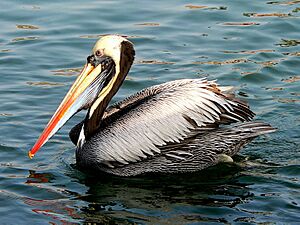Peruvian pelican facts for kids
Quick facts for kids Peruvian pelican |
|
|---|---|
 |
|
| Conservation status | |
| Scientific classification | |
| Genus: |
Pelecanus
|
| Species: |
thagus
|
 |
|
| Synonyms | |
|
|
The Peruvian pelican (Pelecanus thagus) is a large water bird from the pelican family. You can find it along the west coast of South America. These amazing birds build their nests in big groups called colonies. They live from central Chile all the way up to northern Peru. Sometimes, they also visit southern Chile and Ecuador. People used to think it was just a type of brown pelican, but now we know it's its own special species!
Contents
What Does the Peruvian Pelican Look Like?
These pelicans are mostly dark in color. They have a cool white stripe that starts at the top of their bill, goes over their head, and down the sides of their neck. They also have long, fluffy feathers on top of their heads, almost like a crest!
This pelican is much bigger than the brown pelican. It can weigh between 5 and 7 kilograms (about 11 to 15 pounds). It's also quite long, measuring about 137 to 152 centimeters (4.5 to 5 feet) from head to tail. Its wings can spread out to about 228 centimeters (7.5 feet) wide!
Besides being larger, the Peruvian pelican has longer crest feathers. Its gular pouch (the stretchy skin under its bill), beak, and certain wing feathers also have different colors compared to the brown pelican.
Life Cycle and Reproduction
When Do Peruvian Pelicans Breed?
The main time for Peruvian pelicans to have their babies is from September to March. They usually lay two or three eggs at a time.
How Do They Raise Their Young?
The parents take turns keeping the eggs warm for about 4 to 5 weeks. This is called incubation. After the chicks hatch, the parents spend about 3 months raising them until they are ready to be on their own.
These pelicans like to nest in very large groups along the coast.
What Do Peruvian Pelicans Eat?
Peruvian pelicans mainly eat different kinds of fish. Unlike the brown pelican, they don't dive from very high up to catch their food. Instead, they dive from a lower height or simply feed while swimming on the water's surface.
Sometimes, they might eat other things. This could include baby birds like imperial shags or young Peruvian diving petrels. They also sometimes eat gray gulls.
Their Favorite Food: Anchovies
A big part of their diet is small fish called anchovies. In fact, pelicans living in the northern Humboldt Current System eat almost only one type of anchovy, called the Peruvian anchoveta.
These birds find their food in areas where cold water from the deep ocean rises to the surface. This process is called upwelling. It brings lots of nutrients and fish, especially along the Humboldt Current.
Conservation Status
The Peruvian pelican's population was first checked in 2008 for the IUCN Red List. At that time, it was listed as Near threatened. This means it's not in immediate danger, but its population could become threatened in the future.
Its status was checked again in 2018. It was still listed as Near threatened, which is good news. Even better, its population was actually growing!
One thing that might affect these pelicans is competition with fishing boats. Both the pelicans and the fishing industry rely on anchovies as a food source.
Gallery
-
Peruvian pelican in Pan de Azúcar National Park, Chile
-
Peruvian pelicans in the Ballestas Islands, Peru
-
Peruvian pelican in Paracas, Peru








